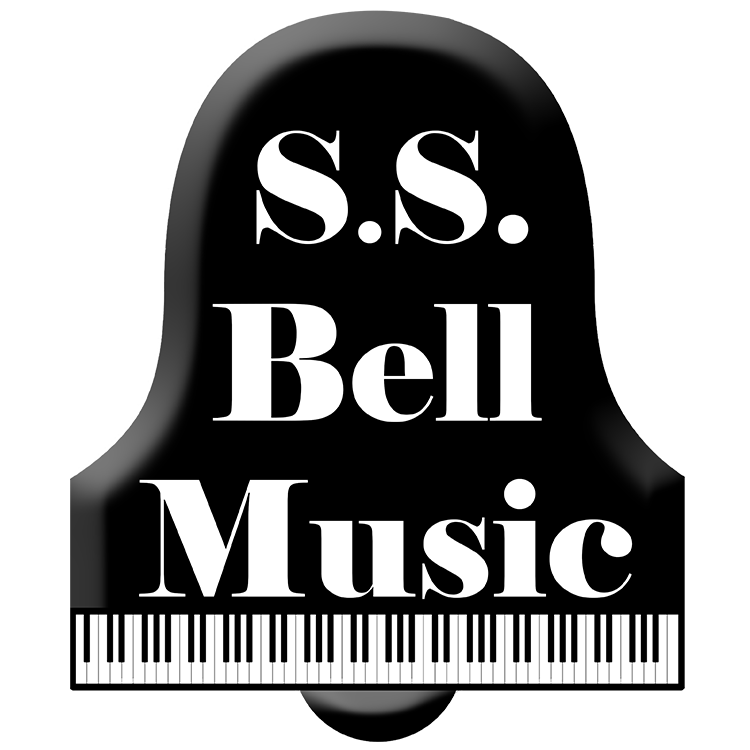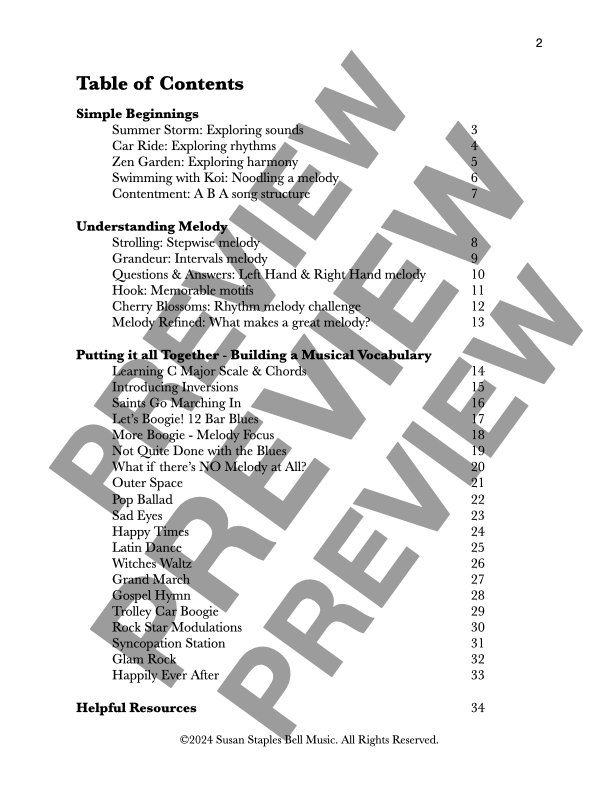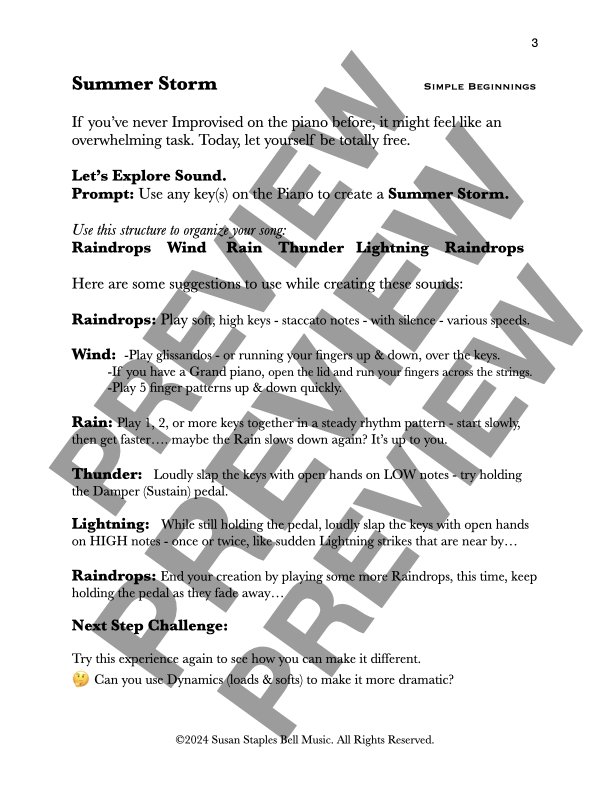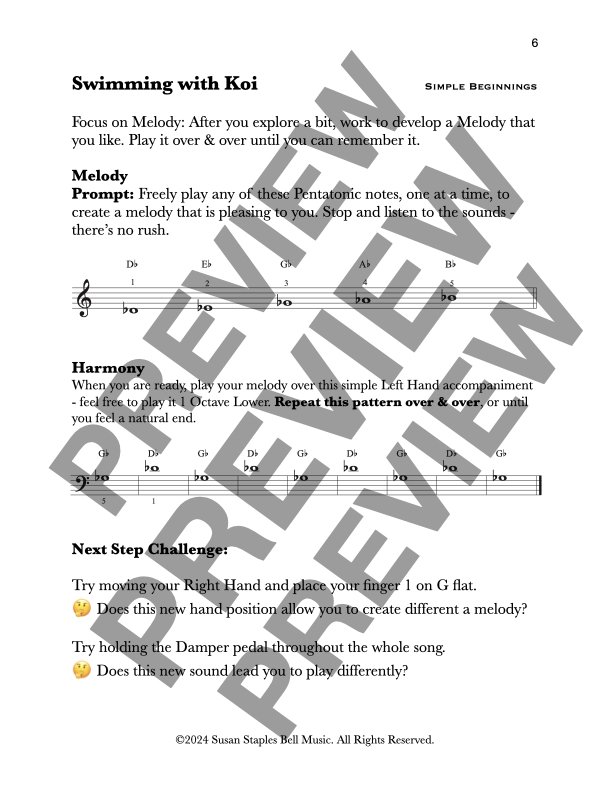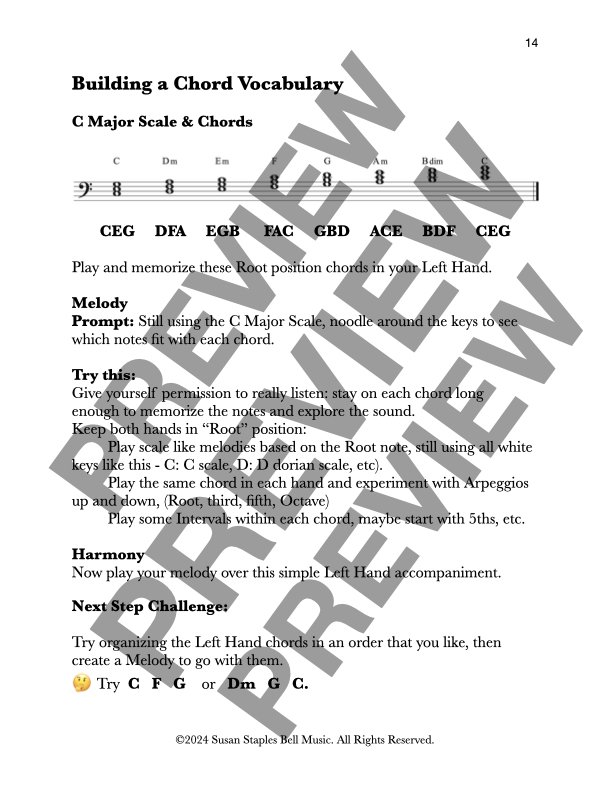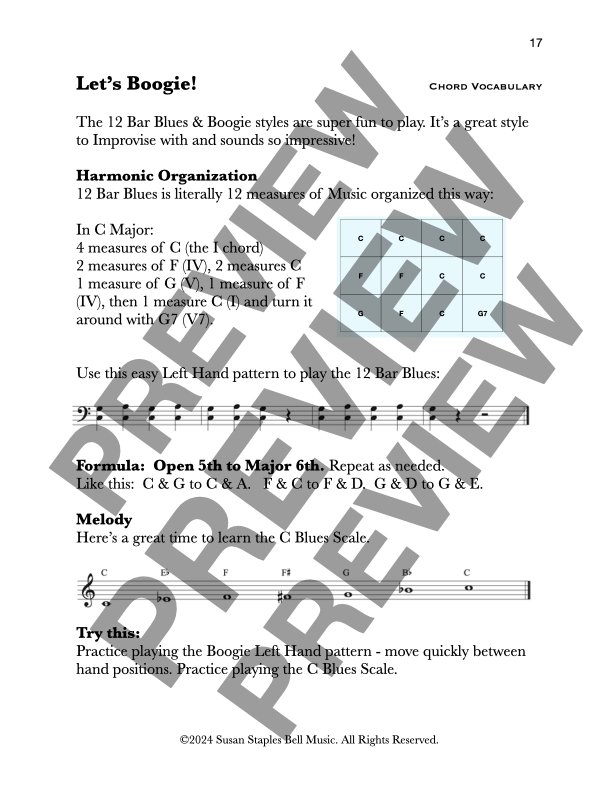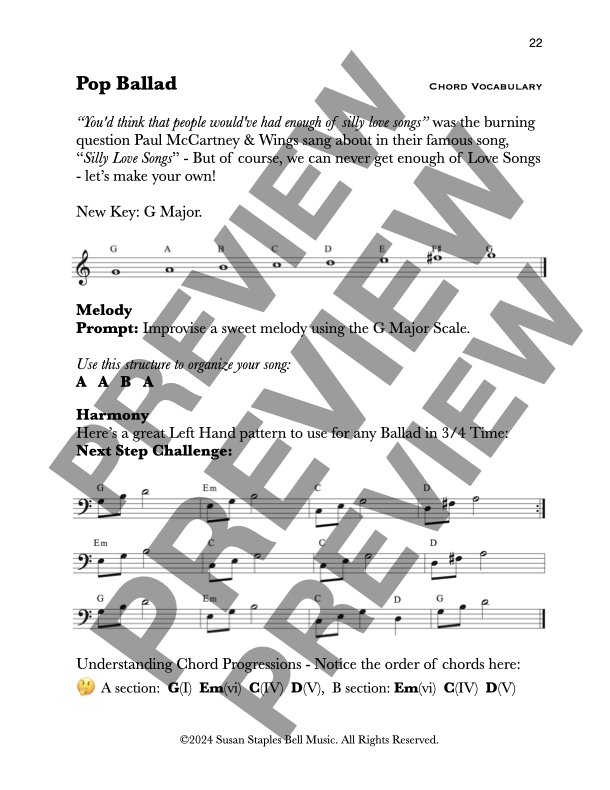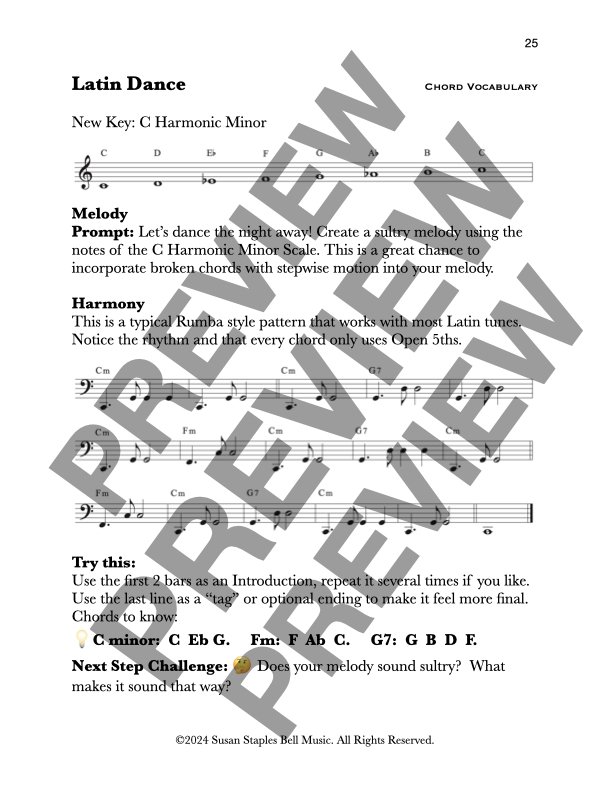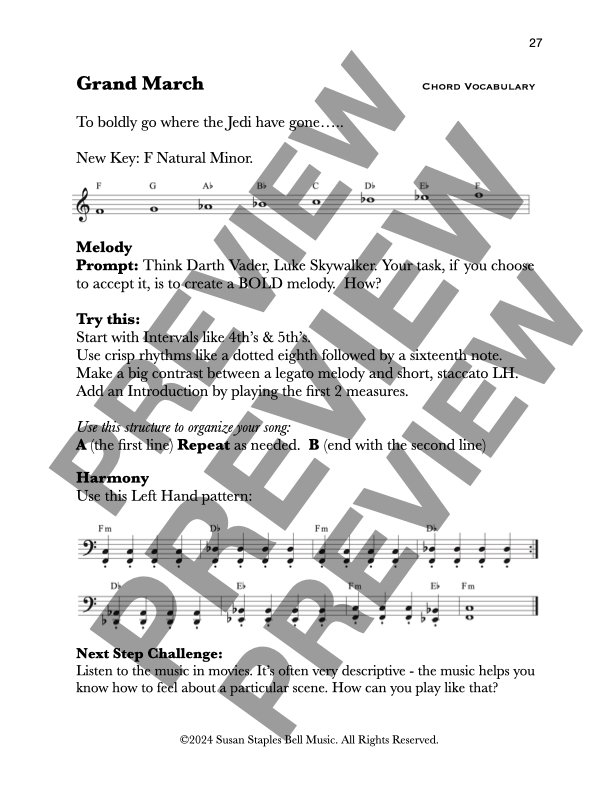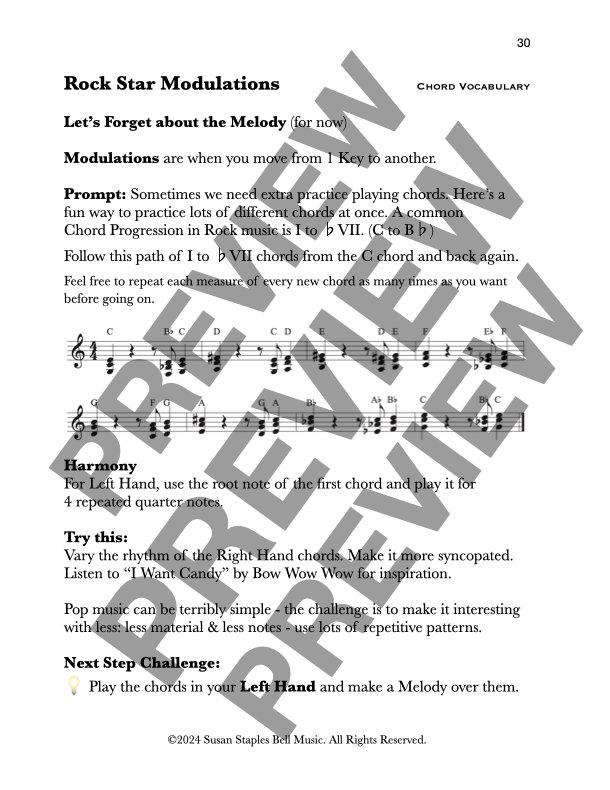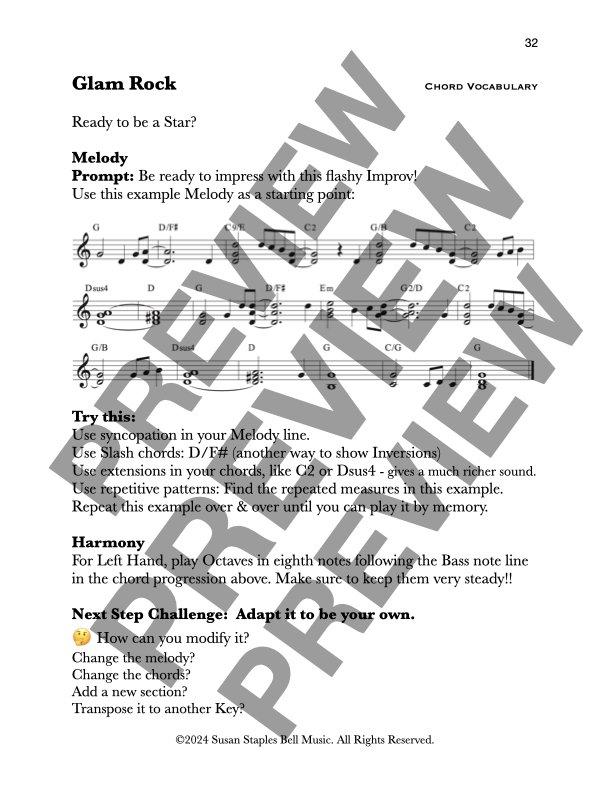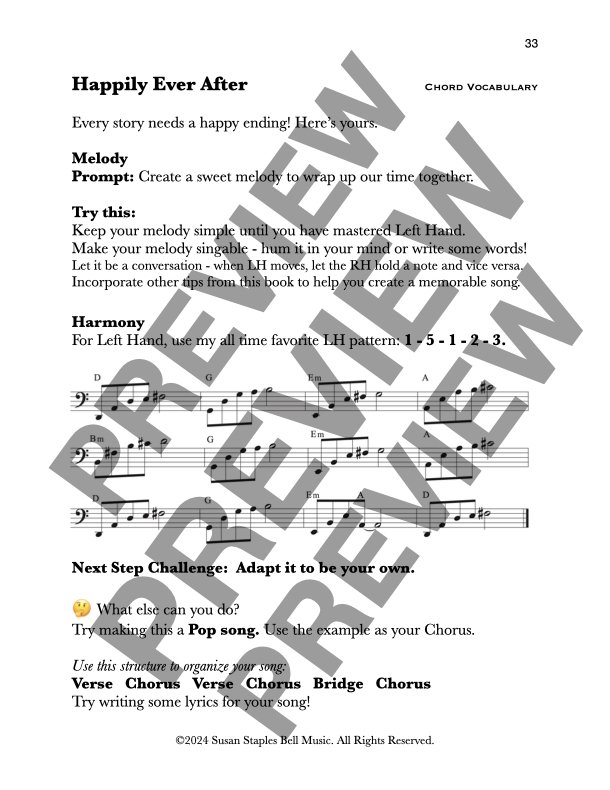Dapples & Grey's, an Improvisation Study BACKING TRACK
Dapples & Grey’s, BACKING TRACK
an Improvisation Study + Theory for Multi Level Piano Ensemble
Chord Progression from “All the Pretty Little Horses” + Lead Sheet included.
Created by Susan Staples Bell, ASCAP
Students love to improvise- let’s give them a safe structure in which to explore.
Here is a Multi Level Piano Ensemble arrangement that can be used in so many ways.
1. Theory activity- name the chords, analyze the chord progression.
2. Improvisation exploration- you don’t need a group! Teacher can play one of the parts or use the backing track, while students explore.
3. Ensemble playing.
4. Sight reading practice.
5. Lead Sheet included- explore playing using Chord symbols.
The written Score and 4 parts are the accompaniment structure. Start by teaching the individual parts and when ready, have the ensemble play the accompaniment while one student tries improvising. Repeat as necessary to allow more students to try improvising.
In the Elementary level, where we learn simple 2 note chords to play and introduce the idea that we can improvise using only 5 notes: D E F G A. As others play the accompaniment provided, one student experiments with these 5 notes.
Younger students might stay at this level (practicing their accompaniment part or deciding on different patterns to play with their 5 notes) while you introduce the next level: Late Elementary. Now we introduce the names of the chords and their notes and notice their accompaniment part is broken chords. Perhaps they might want to use broken chords in their improvisation? The next level is Early Intermediate where we add the idea of Triads in Root, 1st and 2nd Inversions. Their accompaniment is full them! Can they identify the chord and tell us which one is in 2nd inversion? Also notice, the Bass line has moved to octaves. Lastly, the Intermediate part incorporates a suggestion of a melody line in intervals like 6ths, Passing tones and a more interesting Bass Line. At this level, perhaps the students can incorporate both hands in their improvisations?
Make sure to grab the FREE Backing Track. Great to share with students to explore at home on their own or use in class for a low stress option.
This STUDIO LICENSE grants multiple copies in YOUR Studio ONLY. Thank you for honoring the composer’s work by not sharing with other teachers.
Dapples & Grey’s, BACKING TRACK
an Improvisation Study + Theory for Multi Level Piano Ensemble
Chord Progression from “All the Pretty Little Horses” + Lead Sheet included.
Created by Susan Staples Bell, ASCAP
Students love to improvise- let’s give them a safe structure in which to explore.
Here is a Multi Level Piano Ensemble arrangement that can be used in so many ways.
1. Theory activity- name the chords, analyze the chord progression.
2. Improvisation exploration- you don’t need a group! Teacher can play one of the parts or use the backing track, while students explore.
3. Ensemble playing.
4. Sight reading practice.
5. Lead Sheet included- explore playing using Chord symbols.
The written Score and 4 parts are the accompaniment structure. Start by teaching the individual parts and when ready, have the ensemble play the accompaniment while one student tries improvising. Repeat as necessary to allow more students to try improvising.
In the Elementary level, where we learn simple 2 note chords to play and introduce the idea that we can improvise using only 5 notes: D E F G A. As others play the accompaniment provided, one student experiments with these 5 notes.
Younger students might stay at this level (practicing their accompaniment part or deciding on different patterns to play with their 5 notes) while you introduce the next level: Late Elementary. Now we introduce the names of the chords and their notes and notice their accompaniment part is broken chords. Perhaps they might want to use broken chords in their improvisation? The next level is Early Intermediate where we add the idea of Triads in Root, 1st and 2nd Inversions. Their accompaniment is full them! Can they identify the chord and tell us which one is in 2nd inversion? Also notice, the Bass line has moved to octaves. Lastly, the Intermediate part incorporates a suggestion of a melody line in intervals like 6ths, Passing tones and a more interesting Bass Line. At this level, perhaps the students can incorporate both hands in their improvisations?
Make sure to grab the FREE Backing Track. Great to share with students to explore at home on their own or use in class for a low stress option.
This STUDIO LICENSE grants multiple copies in YOUR Studio ONLY. Thank you for honoring the composer’s work by not sharing with other teachers.
Dapples & Grey’s, BACKING TRACK
an Improvisation Study + Theory for Multi Level Piano Ensemble
Chord Progression from “All the Pretty Little Horses” + Lead Sheet included.
Created by Susan Staples Bell, ASCAP
Students love to improvise- let’s give them a safe structure in which to explore.
Here is a Multi Level Piano Ensemble arrangement that can be used in so many ways.
1. Theory activity- name the chords, analyze the chord progression.
2. Improvisation exploration- you don’t need a group! Teacher can play one of the parts or use the backing track, while students explore.
3. Ensemble playing.
4. Sight reading practice.
5. Lead Sheet included- explore playing using Chord symbols.
The written Score and 4 parts are the accompaniment structure. Start by teaching the individual parts and when ready, have the ensemble play the accompaniment while one student tries improvising. Repeat as necessary to allow more students to try improvising.
In the Elementary level, where we learn simple 2 note chords to play and introduce the idea that we can improvise using only 5 notes: D E F G A. As others play the accompaniment provided, one student experiments with these 5 notes.
Younger students might stay at this level (practicing their accompaniment part or deciding on different patterns to play with their 5 notes) while you introduce the next level: Late Elementary. Now we introduce the names of the chords and their notes and notice their accompaniment part is broken chords. Perhaps they might want to use broken chords in their improvisation? The next level is Early Intermediate where we add the idea of Triads in Root, 1st and 2nd Inversions. Their accompaniment is full them! Can they identify the chord and tell us which one is in 2nd inversion? Also notice, the Bass line has moved to octaves. Lastly, the Intermediate part incorporates a suggestion of a melody line in intervals like 6ths, Passing tones and a more interesting Bass Line. At this level, perhaps the students can incorporate both hands in their improvisations?
Make sure to grab the FREE Backing Track. Great to share with students to explore at home on their own or use in class for a low stress option.
This STUDIO LICENSE grants multiple copies in YOUR Studio ONLY. Thank you for honoring the composer’s work by not sharing with other teachers.

